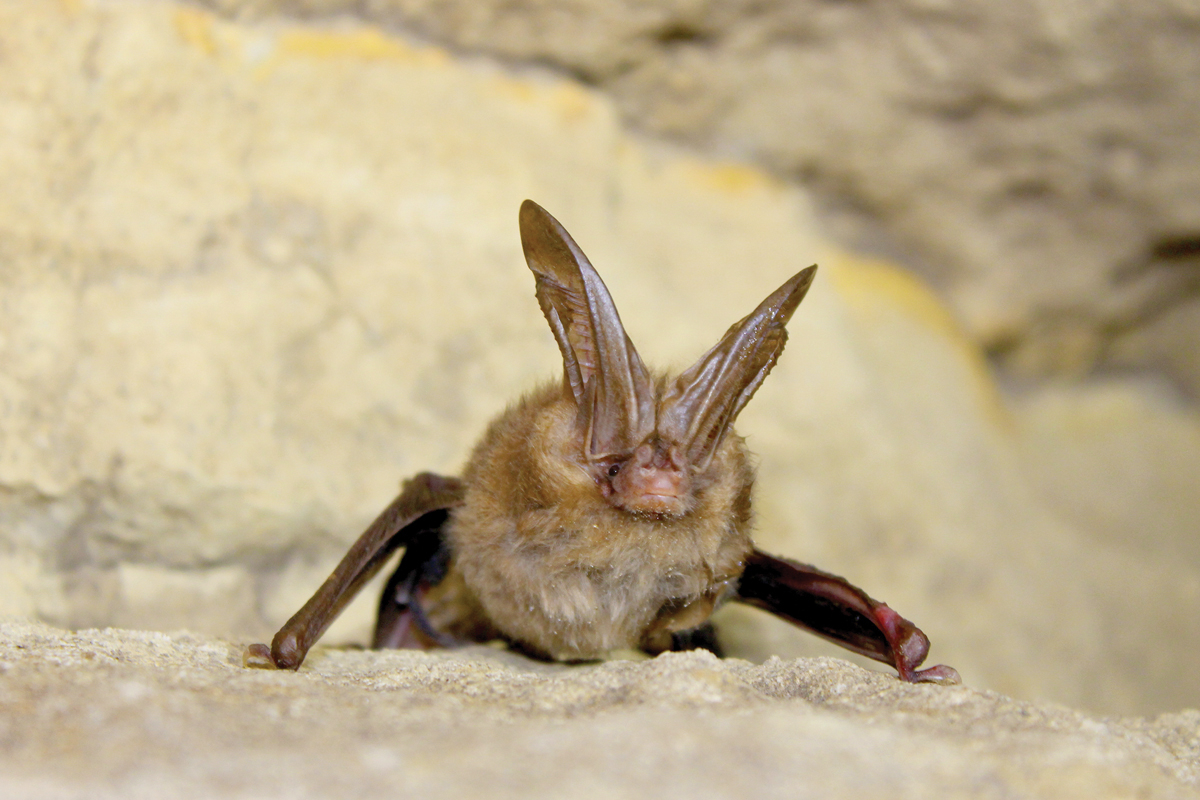Forest plan will harm endangered bats, conservation groups say
 The Virginia big-eared bat has been listed as endangered since 1979. Larisa Bishop-Boros photo
The Virginia big-eared bat has been listed as endangered since 1979. Larisa Bishop-Boros photo
Groups file intent to sue Forest Service
A group of five conservation organizations has declared its intent to sue the U.S. Forest Service unless it corrects alleged Endangered Species Act violations committed in completing the new Pisgah-Nantahala Forest Management Plan . These conservation groups — consisting of Defenders of Wildlife, the Center for Biological Diversity, The Wilderness Society, MountainTrue and the Sierra Club, and represented by the Southern Environmental Law Center — say that the plan has “glaring flaws” that threaten the survival of endangered forest bats.
“It is unacceptable that the Nantahala-Pisgah Forest Plan puts imperiled wildlife at even greater risk of extinction,” said Jess Riddle, conservation specialist for The Wilderness Society. “The Forest Service has blatantly ignored the best available science and shirked its legal duties to protect forest resources at nearly every step of the way in this planning process, leading to a plan that prioritizes logging in the wrong places and trivializes intact mature and old-growth forest habitat.”
The conservation groups say that if the Forest Service does not take “all necessary measures” to rectify the alleged ESA violations, they will sue the agency.
“Our incredibly diverse ecosystems deserve a better plan,” said Josh Kelly, public lands field biologist for MountainTrue. “The people who love and use these forests deserve a better plan. And MountainTrue and our litigation partners are willing to go to court to win a plan that we can all be proud of.”
Endangered species and the forest plan
In February, the Forest Service wrapped up a decade-long process to revise the plan governing the Pisgah and Nantahala national forests for the first time since 1987. The 361-page plan lays out the framework for management decisions on the forests’ 1.1 million acres, which contain the highest elevations east of the Mississippi River and a striking diversity of species and landscapes.
The plan was one of the first developed under a 2012 planning rule that emphasized public participation throughout the process. But as it neared its final form, members of the Nantahala Pisgah Forest Partnership, a group of more than 20 organizations that spent years working on a compromise to address their diverse and often competing interests, expressed disappointment that some of its key recommendations had been omitted. When the final plan came out, SELC and four of the five organizations behind the Intent to Sue issued a joint press release decrying the plan as a failure that “turned a tin ear to legitimate input” and “outright dismisses the need to protect thousands of acres of high-priority areas for rare species.” The groups didn’t promise a lawsuit at that point but explicitly declined to rule it out.
Related Items
At the heart of the Intent to Sue filed July 25 is the Biological Opinion document the U.S. Fish and Wildlife Service completed after the Forest Service asked it to analyze how the proposed plan would impact six bat species. The Endangered Species Act requires federal agencies to consult with the FWS anytime a proposed action could affect a listed species or critical habitat. After analyzing plan impacts on 26 species, the Forest Service concluded that the six bat species were the only ones at risk of impact from the plan.
The Biological Opinion doesn’t analyze the effects of specific plan actions, the FWS wrote, but “is a broad-scale analysis” used to “determine the potential for the revised forest plan direction to jeopardize the affected populations of listed species.”
Four of the species — northern long-eared bat, Indiana bat, Virginia big-eared bat and gray bat — are endangered, and the FWS is considering listing the little brown bat and tricolored bat. White-nose syndrome , a fungus-caused disease that has decimated cave-dwelling bat populations since arriving in North America sometime before 2006, has dramatically impacted five of the six species. In less than a decade, one 2021 study found, it wiped out more than 90% of the northern long-eared, little brown and tri-colored bats in existence. Bats are essential to pest control, plant pollination and seed dispersal. Recent studies estimate that , in the U.S. corn industry alone, bats eat enough pests to save more than $1 billion annually in crop damage and pesticide costs, and that the animals’ insect consumption saves more than $3 billion per year across all agricultural production.
The conservation groups claim the Forest Service “ignored public concerns and the best available science” about the plan’s impact on endangered species and used “misleading and inaccurate information to downplay the impacts.” Those impacts are directly related to the “huge increase in logging in sensitive habitats” contained in the plan, the groups said.
Flawed conclusions
To inform its Biological Opinion, the FWS used outputs from the Forest Service’s Ecological Sustainability Evaluation Model, which predicts how groups of species are expected to fare under various planning scenarios. The tool defines outcomes as poor, fair, good or very good. But the Forest Service apparently did not give the FWS the underlying data behind these rankings, the Intent to Sue states, with the FWS accepting Forest Service conclusions “uncritically.”
However, the conservation groups claim, these conclusions are deeply flawed. They list five examples in which the Forest Service allegedly failed to provide information to the FWS or supplied inaccurate information.
The first example listed deals with the Forest Service’s “inaccurate and illogical assumptions” about how often natural forest disturbances like fires, landslides or storms would occur in the future. Data show that the rate of disturbance increased for each of the last four decades and more than doubled between the first and fifth decade, but instead of assuming natural disturbance levels would continue to increase, the Forest Service assumed that the rate seen by decade over the past 50 years would cycle over the next 200. In other words, disturbance levels in the 2020s would be equal to those in the 1970s and levels in the 2030s would mirror those in the 1980s.
“Not only does the modeling assume no increase in disturbance levels as global climate change continues to intensify — an assumption contradicted in other portions of the Forest Service’s analysis — it also predicts that levels will dramatically drop during the relevant timeframe,” the intent to Sue states.
The document also claims that the Forest Service withheld information about the plan’s impact on mid- to late-aged forests, incorrectly stated that plan impacts from road construction would be negligible, failed to provide information about logging levels on adjacent state and private lands and exaggerated the benefit two of the bat species would incur from the type of clearings likely to be created under the plan.
‘Garbage in, garbage out’
The Intent to Sue then alleges that, after the Forest Service tipped the scales by supplying the FWS with substandard information, it “arbitrarily and capriciously” relied on the resulting Biological Opinion.
“Since the agency put ‘garbage in,’ it could only expect to get garbage out,” the document states. “Second, because FWS’s BiOp is legally flawed and fails to discuss available information that would undercut the opinion’s conclusion, the Forest Service acted unlawfully by relying on the consequently flawed BiOp in its Record of Decision.”
The document goes on to list 17 ways in which the conservation groups believe the Biological Opinion to be flawed.
Several of these alleged flaws have to do with failures to consider where specifically certain species of bats are found in the forest and the cumulative effects of various environmental pressures on these bat populations. Evidence shows that many of these bat species reuse the same areas year after year, so eliminating these key habitats could have “a cascade of negative effects.”
“The BiOp assumes that since the listed bats can still find suitable habitat throughout the forests, where these impacts occur within the forests is irrelevant,” the document says. “That cannot be true; logging around the caves inhabited by the Virginia big-eared bat, for example, could devastate the one major maternity colony in North Carolina.”
The Biological Opinion is also flawed in its conception of short-term and long-term impacts to the bat species, the conservation groups say. Bats live long lives and reproduce slowly, and their populations levels are already dangerously low.
“Dismissing the plan’s impacts to bat habitat as ‘temporary’ fails to account for basic bat biology as well as the imperiled status of the species, violating the best available science requirement,” the Intent to Sue states.
The Biological Opinion also fails to adequately consider how threats like climate change and white-nose syndrome will impact the bats or conservation measures in the plan, the conservation groups say. For example, in other contexts, the Forest Service has recognized that certain tree species that provide important bat habitat could be harmed by climate change. The Biological Opinion references plan goals to promote these species but doesn’t discuss how climate change might impact success.
Representatives from the Forest Service and FWS declined to comment on the pending litigation, but the Forest Service sent a statement encouraging ongoing public dialogue and emphasizing the long, collaborative process used to develop the new plan.
“Diverse opinions and ideas about how to manage the Nantahala and Pisgah are inherent in the complexity of carrying out the Forest Service’s multiple use mission in some of the most visited and biodiverse national forests in the country,” the statement said. “Our commitment is that we will always strive to listen to and convene diverse perspectives to make the best decisions, informed by science, so we can create healthy and resilient forests now and for the future.”









